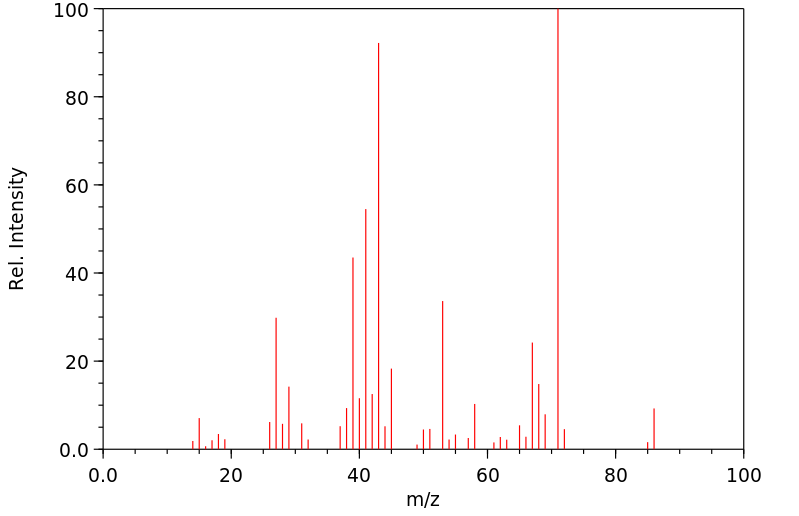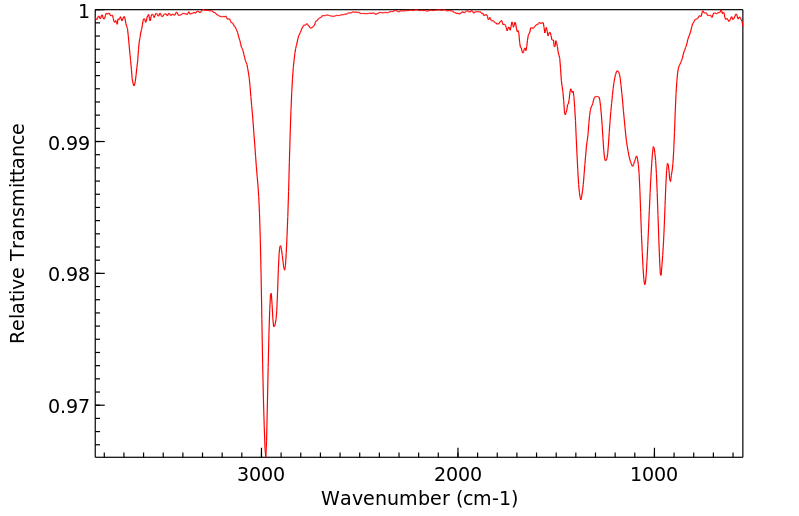3-戊烯-2-醇 | 1569-50-2
中文名称
3-戊烯-2-醇
中文别名
——
英文名称
3-penten-2-ol
英文别名
pent-3-en-2-ol;methyl-3-buten-2-ol
CAS
1569-50-2
化学式
C5H10O
mdl
——
分子量
86.1338
InChiKey
GJYMQFMQRRNLCY-UHFFFAOYSA-N
BEILSTEIN
——
EINECS
——
-
物化性质
-
计算性质
-
ADMET
-
安全信息
-
SDS
-
制备方法与用途
-
上下游信息
-
文献信息
-
表征谱图
-
同类化合物
-
相关功能分类
-
相关结构分类
物化性质
-
熔点:14.19°C (estimate)
-
沸点:120-122 °C(lit.)
-
密度:0.843 g/mL at 25 °C(lit.)
-
闪点:82 °F
-
LogP:0.990 (est)
-
稳定性/保质期:
在常温常压下保持稳定,应避免与不相容的材料和火源接触。
计算性质
-
辛醇/水分配系数(LogP):0.8
-
重原子数:6
-
可旋转键数:1
-
环数:0.0
-
sp3杂化的碳原子比例:0.6
-
拓扑面积:20.2
-
氢给体数:1
-
氢受体数:1
安全信息
-
危险等级:3.2
-
危险品标志:Xn
-
安全说明:S16,S23,S24/25
-
危险类别码:R10
-
WGK Germany:3
-
海关编码:29052990
-
包装等级:III
-
危险类别:3.2
-
危险品运输编号:UN 1987 3/PG 3
-
储存条件:密封储存,应存放在阴凉、干燥的库房中,并远离火源和易燃易爆区域。
SDS
| Name: | 3-Penten-2-Ol 97% Mixture of Cis/Trans (>90% Trans) Material Safety Data Sheet |
| Synonym: | None |
| CAS: | 1569-50-2 |
Synonym:None
Section 2 - COMPOSITION, INFORMATION ON INGREDIENTS
| CAS# | Chemical Name | content | EINECS# |
| 1569-50-2 | 3-Penten-2-Ol | 97% | 216-376-6 |
Risk Phrases: 10
Section 3 - HAZARDS IDENTIFICATION
EMERGENCY OVERVIEW
Flammable.The toxicological properties of this material have not been fully investigated.
Potential Health Effects
Eye:
May cause eye irritation.
Skin:
May cause skin irritation.
Ingestion:
May cause irritation of the digestive tract. The toxicological properties of this substance have not been fully investigated.
Inhalation:
May cause respiratory tract irritation. The toxicological properties of this substance have not been fully investigated. Vapors may cause dizziness or suffocation.
Chronic:
No information found.
Section 4 - FIRST AID MEASURES
Eyes: Flush eyes with plenty of water for at least 15 minutes, occasionally lifting the upper and lower eyelids. Get medical aid.
Skin:
Get medical aid. Flush skin with plenty of water for at least 15 minutes while removing contaminated clothing and shoes. Wash clothing before reuse.
Ingestion:
Never give anything by mouth to an unconscious person. Get medical aid. Do NOT induce vomiting. If conscious and alert, rinse mouth and drink 2-4 cupfuls of milk or water. Wash mouth out with water.
Inhalation:
Remove from exposure and move to fresh air immediately. If not breathing, give artificial respiration. If breathing is difficult, give oxygen. Get medical aid.
Notes to Physician:
Section 5 - FIRE FIGHTING MEASURES
General Information:
As in any fire, wear a self-contained breathing apparatus in pressure-demand, MSHA/NIOSH (approved or equivalent), and full protective gear. Vapors may form an explosive mixture with air.
Vapors can travel to a source of ignition and flash back. During a fire, irritating and highly toxic gases may be generated by thermal decomposition or combustion. Will burn if involved in a fire. Use water spray to keep fire-exposed containers cool. Water may be ineffective. Material is lighter than water and a fire may be spread by the use of water. Containers may explode in the heat of a fire.
Flammable liquid and vapor. Vapors may be heavier than air. They can spread along the ground and collect in low or confined areas.
Extinguishing Media:
For small fires, use dry chemical, carbon dioxide, water spray or alcohol-resistant foam. For large fires, use water spray, fog, or alcohol-resistant foam. Do NOT use water directly on fire. Use water spray to cool fire-exposed containers. Water may be ineffective. Do NOT use straight streams of water.
Section 6 - ACCIDENTAL RELEASE MEASURES
General Information: Use proper personal protective equipment as indicated in Section 8.
Spills/Leaks:
Absorb spill with inert material (e.g. vermiculite, sand or earth), then place in suitable container. Avoid runoff into storm sewers and ditches which lead to waterways. Clean up spills immediately, observing precautions in the Protective Equipment section. Remove all sources of ignition. Use a spark-proof tool. Provide ventilation. A vapor suppressing foam may be used to reduce vapors.
Section 7 - HANDLING and STORAGE
Handling:
Wash thoroughly after handling. Use with adequate ventilation.
Ground and bond containers when transferring material. Use spark-proof tools and explosion proof equipment. Avoid contact with eyes, skin, and clothing. Empty containers retain product residue, (liquid and/or vapor), and can be dangerous. Take precautionary measures against static discharges. Keep container tightly closed.
Keep away from heat, sparks and flame. Avoid ingestion and inhalation. Do not pressurize, cut, weld, braze, solder, drill, grind, or expose empty containers to heat, sparks or open flames.
Storage:
Keep away from heat, sparks, and flame. Keep away from sources of ignition. Store in a tightly closed container. Store in a cool, dry, well-ventilated area away from incompatible substances.
Flammables-area.
Section 8 - EXPOSURE CONTROLS, PERSONAL PROTECTION
Engineering Controls:
Facilities storing or utilizing this material should be equipped with an eyewash facility and a safety shower. Use adequate ventilation to keep airborne concentrations low.
Exposure Limits CAS# 1569-50-2: Russia: 10 mg/m3 TWA Personal Protective Equipment Eyes: Wear appropriate protective eyeglasses or chemical safety goggles as described by OSHA's eye and face protection regulations in 29 CFR 1910.133 or European Standard EN166.
Skin:
Wear appropriate protective gloves to prevent skin exposure.
Clothing:
Wear appropriate protective clothing to prevent skin exposure.
Respirators:
A respiratory protection program that meets OSHA's 29 CFR 1910.134 and ANSI Z88.2 requirements or European Standard EN 149 must be followed whenever workplace conditions warrant respirator use.
Section 9 - PHYSICAL AND CHEMICAL PROPERTIES
Physical State: Liquid
Color: clear almost colorless
Odor: Not available.
pH: Not available.
Vapor Pressure: Not available.
Viscosity: Not available.
Boiling Point: 119 - 121 deg C @ 760.00mm Hg
Freezing/Melting Point: Not available.
Autoignition Temperature: Not available.
Flash Point: 27 deg C ( 80.60 deg F)
Explosion Limits, lower: Not available.
Explosion Limits, upper: Not available.
Decomposition Temperature:
Solubility in water:
Specific Gravity/Density: .8430g/cm3
Molecular Formula: C5H10O
Molecular Weight: 86.13
Section 10 - STABILITY AND REACTIVITY
Chemical Stability:
Stable at room temperature in closed containers under normal storage and handling conditions.
Conditions to Avoid:
Incompatible materials, ignition sources, excess heat.
Incompatibilities with Other Materials:
Oxidizing agents.
Hazardous Decomposition Products:
Carbon monoxide, irritating and toxic fumes and gases, carbon dioxide.
Hazardous Polymerization: Has not been reported
Section 11 - TOXICOLOGICAL INFORMATION
RTECS#:
CAS# 1569-50-2 unlisted.
LD50/LC50:
Not available.
Carcinogenicity:
3-Penten-2-Ol - Not listed by ACGIH, IARC, or NTP.
Section 12 - ECOLOGICAL INFORMATION
Section 13 - DISPOSAL CONSIDERATIONS
Dispose of in a manner consistent with federal, state, and local regulations.
Section 14 - TRANSPORT INFORMATION
IATA
Shipping Name: ALCOHOLS, N.O.S.*
Hazard Class: 3
UN Number: 1987
Packing Group: III
IMO
Shipping Name: ALCOHOLS, N.O.S.
Hazard Class: 3.3
UN Number: 1987
Packing Group: III
RID/ADR
Shipping Name: ALCOHOLS, FLAMMABLE, N.O.S.
Hazard Class: 3
UN Number: 1987
Packing group: III
Section 15 - REGULATORY INFORMATION
European/International Regulations
European Labeling in Accordance with EC Directives
Hazard Symbols: Not available.
Risk Phrases:
R 10 Flammable.
Safety Phrases:
S 9 Keep container in a well-ventilated place.
S 16 Keep away from sources of ignition - No
smoking.
S 28A After contact with skin, wash immediately with
plenty of water.
S 33 Take precautionary measures against static
discharges.
S 37 Wear suitable gloves.
S 45 In case of accident or if you feel unwell, seek
medical advice immediately (show the label where
possible).
WGK (Water Danger/Protection)
CAS# 1569-50-2: No information available.
Canada
CAS# 1569-50-2 is listed on Canada's NDSL List.
CAS# 1569-50-2 is not listed on Canada's Ingredient Disclosure List.
US FEDERAL
TSCA
CAS# 1569-50-2 is listed on the TSCA inventory.
SECTION 16 - ADDITIONAL INFORMATION
N/A
上下游信息
-
下游产品
中文名称 英文名称 CAS号 化学式 分子量 —— (S)-3-penten-2-ol 95782-14-2 C5H10O 86.1338
反应信息
-
作为反应物:描述:参考文献:名称:Levene; Walti, Journal of Biological Chemistry, 1932, vol. 94, p. 356摘要:DOI:
-
作为产物:参考文献:名称:综合验证辅助配体,利用钼配合物对酮进行高效转移氢化摘要:开发了与N 1、N 1 -二烷基-N 2 -(5,6,7,8-四氢喹啉-8-基)乙烷-1,2-二胺和辅助配体连接的钼配合物,提供各种结构特征:[ NN H /NN H N]Mo(CO) 4/3 ( Mo1 –Mo3 ), [NN H N]Mo(CO) 2 Br ( Mo4–Mo5 ), [NN H ]Mo(CO)(η 3 -C 3 H 5 )Br ( Mo6 ) 和 [NN H N/S]Mo(CO)(PPh 3 ) 2 ( Mo7–Mo8)。所有配合物在模型底物(苯乙酮)的转移氢化 (TH) 中均具有高活性,可提供出色的 1-苯基乙醇产率。与辅助配体 Br、PPh 3和 CO的变化相比,配体骨架的结构变化对催化剂性能的影响不大。这种结构演变提供了配合物 [Mo(NN H )(η 3 -C 3 H 5 )(CO) 2 Br] ( Mo6) 作为最有效的催化剂,不仅适用于苯乙酮的转移氢化,而且适用于各种酮类(多达DOI:10.1039/d2dt01177h
文献信息
-
Highly Efficient Redox Isomerization of Allylic Alcohols and Transfer Hydrogenation of Ketones and Aldehydes Catalyzed by Ruthenium Complexes作者:Pei Nian Liu、Kun Dong Ju、Chak Po LauDOI:10.1002/adsc.201000667日期:2011.2.11A dicationic dichloro-bipyridine-ruthenium complex shows very high catalytic activity in redox isomerization of allylic alcohols but a relatively low one in transfer hydrogenation of ketones; surprisingly, the analogous dimethyl-bipyridine-ruthenium complex shows reverse catalytic activities in the two reactions.
-
N–O Tethered Carbenoid Cyclopropanation Facilitates the Synthesis of a Functionalized Cyclopropyl-Fused Pyrrolidine作者:Dimpy Kalia、Gökce Merey、Min Guo、Herman O. SintimDOI:10.1021/jo400788a日期:2013.6.21We report a facile approach to a cyclopropyl-fused pyrrolidine, which contains four stereogenic centers, by employing the N–O tethered carbenoid methodology. The synthesis was facilitated by the development of a direct Mitsunobu reaction of alcohols with N-alkyl-N-hydroxyl amides to give diazo precursors, which upon intramolecular cyclopropanation yielded a library of N–O containing cyclopropyl-fused
-
Studies on the Conversions of Diols and Cyclic Ethers. Part 48. Dehydration of alcohols and diols on the action of dimethylsulfoxide作者:Árpád Molnár、Mihály BartókDOI:10.1002/hlca.19810640204日期:1981.3.18The transformations of 13 alcohols and 13 diols in the presence of a small amount dimethylsulfoxide (1/16 mol) were studied. Relationships were found between the type of the hydroxy compound and the selectivity of the transformation, and conclusions were drawn regarding the transformation mechanism. The ether formation observed with certain alcohols proceeds via a carbenium cation. The reaction conditions
-
Copper(II) Triflate Catalyzed Allylic Arylation of Allylic Alcohols: Direct and Selective Access to<i>C</i>-Allylanilines作者:Ke Chen、Houguang Jeremy Chen、Jonathan Wong、Jinglei Yang、Sumod A. PullarkatDOI:10.1002/cctc.201300408日期:2013.12Copper(II) triflate was used as a simple and commercially available catalyst in the direct amination of allylic alcohols with anilines to provide C‐allylanilines. A wide range of functional groups were tolerated under the reaction conditions, and the products were obtained regioselectivity without the need of an activator. A detailed mechanistic investigation was undertaken. The efficacy of this protocol
-
Reaction-Driven Surface Restructuring and Selectivity Control in Allylic Alcohol Catalytic Aerobic Oxidation over Pd作者:Adam F. Lee、Christine V. Ellis、James N. Naughton、Mark A. Newton、Christopher M. A. Parlett、Karen WilsonDOI:10.1021/ja200684f日期:2011.4.20Synchronous, time-resolved DRIFTS/MS/XAS cycling studies of the vapor-phase selective aerobic oxidation of crotyl alcohol over nanoparticulate Pd have revealed surface oxide as the desired catalytically active phase, with dynamic, reaction-induced Pd redox processes controlling selective versus combustion pathways.
表征谱图
-
氢谱1HNMR
-
质谱MS
-
碳谱13CNMR
-
红外IR
-
拉曼Raman
-
峰位数据
-
峰位匹配
-
表征信息
同类化合物
(反式)-4-壬烯醛
(s)-2,3-二羟基丙酸甲酯
([1-(甲氧基甲基)-1H-1,2,4-三唑-5-基](苯基)甲酮)
(Z)-4-辛烯醛
(S)-氨基甲酸酯β-D-O-葡糖醛酸
(S)-3-(((2,2-二氟-1-羟基-7-(甲基磺酰基)-2,3-二氢-1H-茚满-4-基)氧基)-5-氟苄腈
(R)-氨基甲酸酯β-D-O-葡糖醛酸
(5,5-二甲基-2-(哌啶-2-基)环己烷-1,3-二酮)
(2,5-二氟苯基)-4-哌啶基-甲酮
龙胆苦苷
龙胆二糖甲乙酮氰醇(P)
龙胆二糖丙酮氰醇(P)
龙胆三糖
龙涎酮
齐罗硅酮
齐留通beta-D-葡糖苷酸
鼠李糖
黑芥子苷单钾盐
黑海棉酸钠盐
黑木金合欢素
黑曲霉三糖
黑介子苷
黄尿酸8-O-葡糖苷
麻西那霉素II
麦迪霉素
麦芽糖脎
麦芽糖基海藻糖
麦芽糖1-磷酸酯
麦芽糖
麦芽四糖醇
麦芽四糖
麦芽十糖
麦芽六糖
麦芽五糖水合物
麦芽五糖
麦芽五糖
麦芽五糖
麦芽三糖醇
麦芽三糖
麦芽三糖
麦芽三塘水合
麦芽七糖水合物
麦芽七糖
麦法朵
麦可酚酸-酰基-Β-D-葡糖苷酸
麦利查咪
麝香酮
鹤草酚
鸢尾酚酮 3-C-beta-D-吡喃葡萄糖苷
鸡矢藤苷








